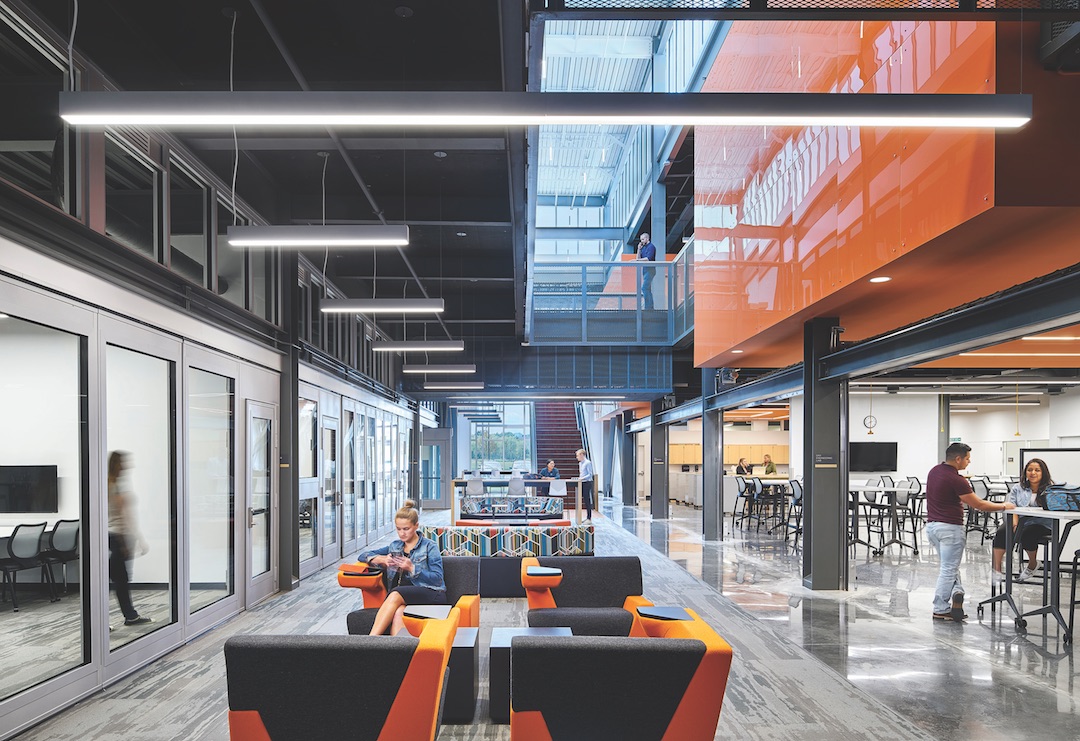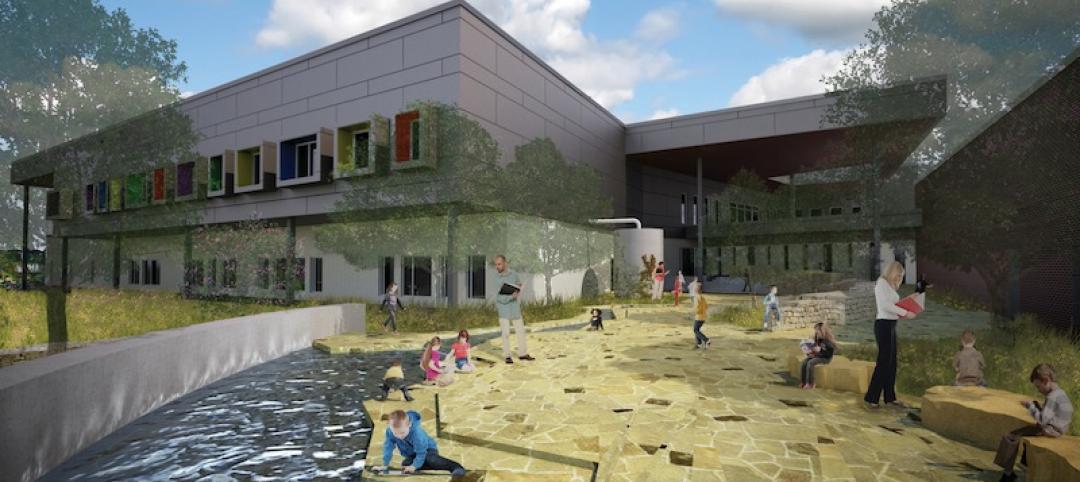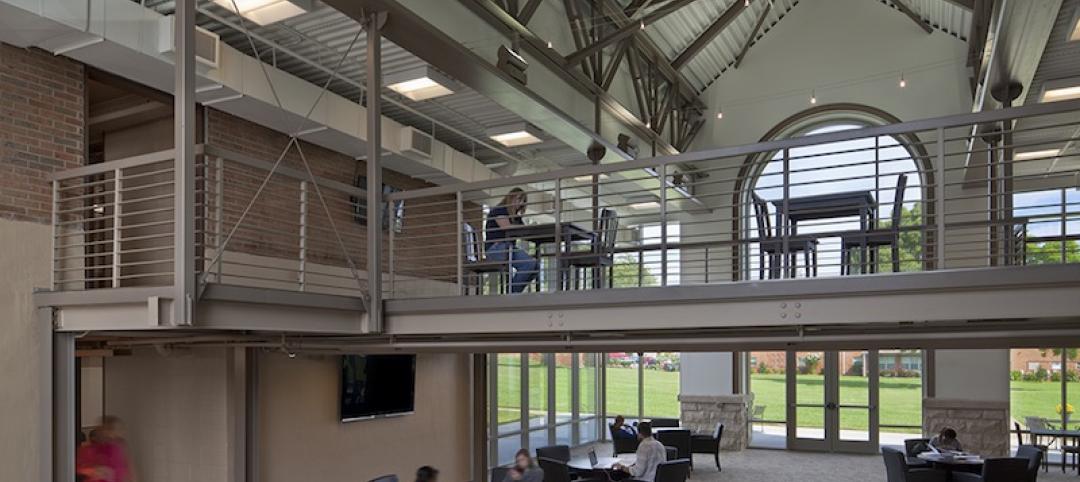Anyone looking for the latest trends that are driving K-12 education might turn their attention to the $82 million, 375,000-sf Olathe (Kan.) West High School, which opened last fall in this Kansas City suburb.
One of those trends is project-based learning, and the 900-plus students in Olathe West’s inaugural class were the first to be issued MacBook Air laptops by that school district. The high school includes eight maker spaces, several of which are equipped with 3D printers.
Another national trend is career and technical education, or CTE, which exposes students to real-life experiences more directly. Olathe West has two distinct CTE learning environments: a space for green technologies that includes a green roof, rainwater catchment, solar panels, and a wind tower; and a place for public safety that can accommodate a full-size fire truck and ambulance. In both instances, the school district partnered with the community—including a local community college and the fire department—to help develop and program the spaces. Students participating in the public safety program can graduate with a certificate toward becoming a police officer, firefighter, or emergency medical technician (EMT).
“High schools are now about sculpting careers and giving students choices and experiences before they get to college or the job market,” says Christian Owens, AIA, Design Principal in Stantec’s Austin, Texas, office,
which designed Olathe West in partnership with Hollis+Miller Architects.
As K-12 schools become more specialized, AEC firms must familiarize themselves better with the job trades toward which schools are shifting their curricula and training.
Another recent Stantec project is the 237,000-sf, $67.5 million Ross Shaw Sterling Aviation High School, which the Houston ISD opened in January 2017. The school offers early-college education in business, automotive repair, and aviation training that includes equipment maintenance, flying, and operations management. The school has its own 7,100-sf hangar for two single-engine planes, flight simulators, and movable workstands for mounting up to 17 engines.
Owens quips that some of Sterling’s students graduate with a pilot’s license before they get their driver’s license.
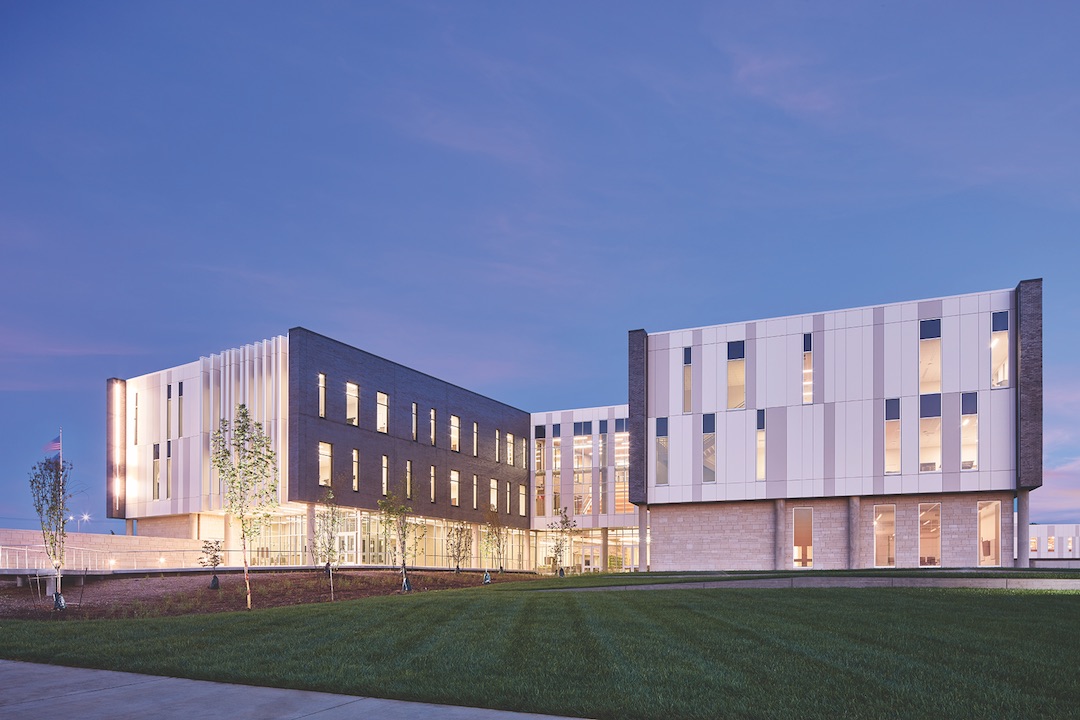 The $85 million Olathe (Kan.) West High School includes eight maker spaces for project-based learning. Alistair Tutton, courtesy Stantec.
The $85 million Olathe (Kan.) West High School includes eight maker spaces for project-based learning. Alistair Tutton, courtesy Stantec.
Redefining school spaces
K-12 has always been a platform for experimentation. And over the past few years, certain trends have risen to the top of school districts’ agendas. Nothing in K-12 gets done without thought being given to how it might contribute to a school’s security and safety. And ask any AEC firm about what it’s working on in education, and the words “collaboration” and “flexibility” inescapably pop up as design criteria.
“Schools are looking at everything as learning space, not just the classroom or the lab,“ says Vaughn Dierks, AIA, LEED AP, Partner with Wold Architects, in St. Paul, Minn. He’s seeing more demand for “scale-up rooms,” with flexible and even removable walls so spaces can be sized depending on their usage.
Jon Moreau, Vice President of Operations with Balfour Beatty Construction Services, in Houston, estimates that the non-classroom space in schools has increased by anywhere from 10% to 20% in square footage over the past several years.
What’s also changing is how schools deliver education, observes Price Jepsen, AIA, NCARB, LEED AP, Vice President and Director of Facilities Planning and Programming with STV Inc., New York. He refers approvingly to collaboration as “a three-ring circus” and marvels at how teachers orchestrate their students’ activities. At the secondary level, he’s seeing a “recognition of the trades” that require skilled training for a technology-focused workplace.
All these trends are redefining space itself within schools. “There are now two types of spaces,” says Jason Mellard, AIA, LEED AP, Senior Associate with Corgan in Dallas. “Open, clean, white space with no distractions and lighting that students and teachers can control; and spaces where groups can be trained.”
He adds that what’s different today in K-12 from five years ago is the emphasis on “connections” that blur the lines separating collaborative spaces, eating spaces, and where ideas and learning are shared.
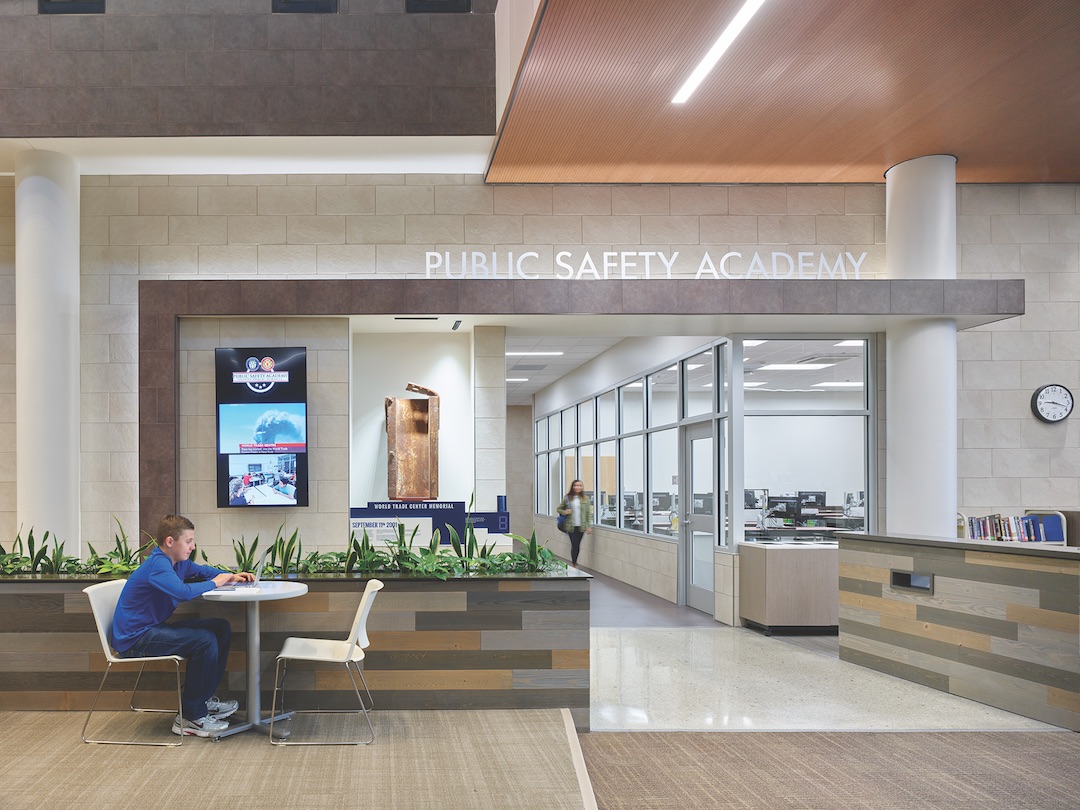 Its Public Safety Academy is among the programs that offer students real-life career training. The Building Team included: Stantec (design architect, in collaboration with Hollis+Miller Architects), Henderson Engineers (owner’s rep, MEP, EE, FP, AV, acoustics, security), Hollis+Miller Architects (SE), and McCownGordon Construction (CM agent). Alistair Tutton, courtesy Stantec.
Its Public Safety Academy is among the programs that offer students real-life career training. The Building Team included: Stantec (design architect, in collaboration with Hollis+Miller Architects), Henderson Engineers (owner’s rep, MEP, EE, FP, AV, acoustics, security), Hollis+Miller Architects (SE), and McCownGordon Construction (CM agent). Alistair Tutton, courtesy Stantec.
Ken Hutchens, a Principal with VLK Architects in Dallas, says the one constant for school spaces is multifunctionality. These include “think sites,” where a teacher and a few students work together; “impact sites,” which can accommodate a half or full class and sometimes serve as presentation areas; and “experience sites,” which are grade-level gathering places.
For a 600-child kindergarten in Tacoma, Wash., DLR Group created learning suites with areas for eating and physical activities. The intention, says Jim French, FAIA, DLR Group’s Global K-12 Education Leader and Senior Principal, was to cut down on the time it was taking to move the kids from room to room. DLR Group is working on four other such early-learning projects, which French says will reduce “transition” time by 70%, or the equivalent of 15 school days.
Just like college
French sees more school districts striving for a “continuum of learning” that is sustainable through all grade levels and carries through to graduation or the workplace.
That “continuum” sometimes finds high school and college overlapping. “There’s a huge desire among school districts to get high school kids certified with college credits,” says French.
Case in point: DLR Group, in collaboration with Gould Evans, managed the construction of the 136,000-sf Missouri Innovation Campus, which opened in August 2017. Developed by the R-7 school district in Lee’s Summit, Mo., and the University of Central Missouri, the Innovation Campus drew about 550 students from 14 districts and 3,000 university students over its first year. Participating high school seniors took college courses three days a week and worked at internships the other two days.
Other districts are creating college-like environments within high schools for career-oriented learning. Shakopee (Minn.) High School is undergoing a $102.5 million, 335,000-sf expansion, which when it’s completed this summer will feature a new academic space divided into six academies: Arts and Communications, Business and Entrepreneurship, Engineering and Manufacturing, Health Sciences, Science and Technology, and a freshman academy.
The building’s classrooms will have extensions for independent and small-group learning. Dierks, whose firm Wold Architects is on the Shakopee project’s Building Team, says the expansion will provide common spaces that are available to the community and businesses for presentations and events.
 The 335,000-sf addition to Shakopee (Minn.) High School includes new academic space that’s divided into six career-oriented academies, and a separate area available for use by local businesses and other community entities. Wold Architects and Engineers.
The 335,000-sf addition to Shakopee (Minn.) High School includes new academic space that’s divided into six career-oriented academies, and a separate area available for use by local businesses and other community entities. Wold Architects and Engineers.
Welcome to the real world
Many school districts are adjusting how and what their schools teach in response to community and corporate concerns that students are not adequately prepared for a workplace that is more complex and competitive.
“There’s been a realization that the world of work is changing dramatically, and the educational structure wasn’t working well for students,” says Philip Riedel, AIA, Principal with NAC Architecture, in Seattle.
The emergence of CTE is a recognition on the part of school districts that A.) not every high school student is going to college, and B.) students need earlier exposure to different professions so they can determine what they might like to do as an adult and get training for that job while in high school.
“A lot of schools are now geared toward
preparing kids for jobs that don’t exist yet,” says Gill Fullen, CCM, Vice President of Education with Balfour Beatty, in Orange County, Calif.
“It’s about beyond today, a career-path focus,” concurs Katherine Mraw, CID, LEED AP, Associate Principal and Design Director of Interiors with LPA, in San Jose, Calif. She elaborates that where elementary and middle schools mold “the whole child,” high schools are more about “getting them ready for the collegiate experience, or for work, and having spaces in the school that support that.”
 The Sequoia Union School District in Menlo Park, Calif., solicited advice from local businesses about the design and programming for its STEM-oriented TIDE Academy, which is part of Menlo Park Small High School. Courtesy LPA.
The Sequoia Union School District in Menlo Park, Calif., solicited advice from local businesses about the design and programming for its STEM-oriented TIDE Academy, which is part of Menlo Park Small High School. Courtesy LPA.
These new Vo-Techs, as one AEC source calls CTE facilities, push careers like engineering and healthcare, but also traditional trades like electrical and engine repair. One of Perkins+Will’s recent design projects—Ridgeview Middle School + High School in Clintwood, Va.—includes “professional spaces” with culinary kitchens, robotics labs, carpentry and auto repair shops, cosmetology salons, and nursing labs. “These courses aren’t taught in the basement anymore,” says Andrew Grote, AIA, LEED AP, Associate Principal and Technical Director in P+W’s Boston office.
The core curriculum is still being taught in CTEs, but it has shifted to “the applied from the abstract,” Grote says. Indeed, districts across the country are placing a premium on the practical application of all learning and instruction.
When NAC Architecture was involved in renovating Inglemoor High School in Kenmore, Wash., it worked with one of that school’s teachers, Mike Wierusz, to turn an outdated drafting room into a sustainability, engineering, and design lab. Wierusz enlisted his students in the design process right from the beginning. NAC facilitated workshops to help students understand its drawings, worked with them to select finishes, and mocked up furniture at 1:1 scale to test ergonomics and functionality.
STV’s Jepsen is quick to note that most districts still center their CTE programs around students being able to read, write, and calculate well for critical thinking and problem solving. “It’s more than just about ‘shop’ time, because the trades today require highly technical skills,” says Jepsen.
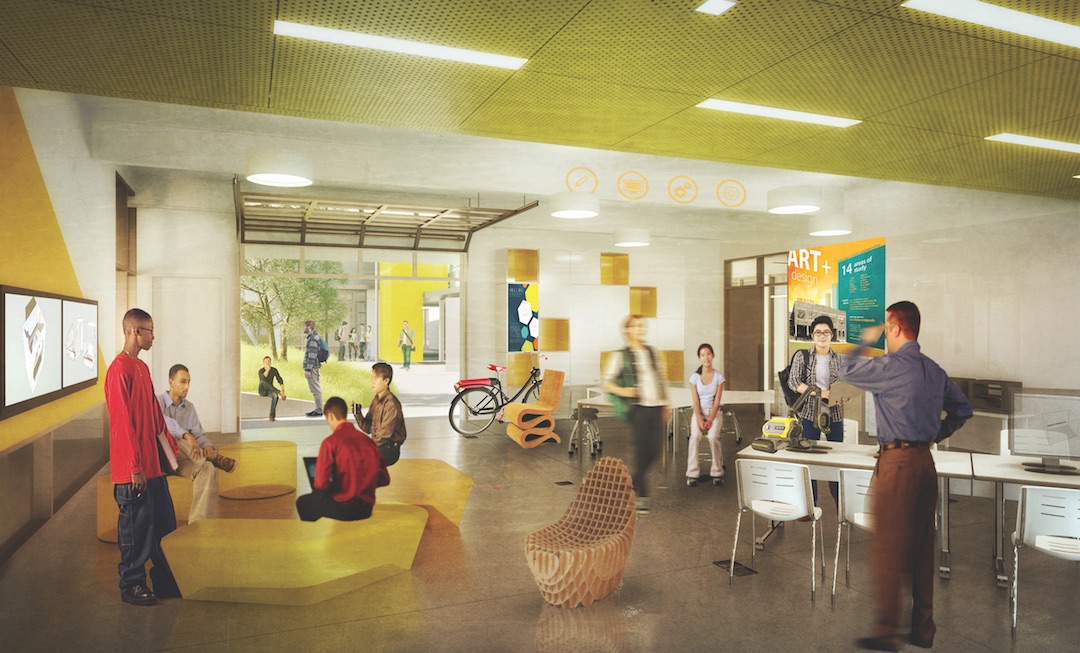 LPA was the designer of the 44,000-sf academy, provided interior and landscape design, and was its structural and MEP engineer. Arntz Buildings was the GC. Courtesy LPA.
LPA was the designer of the 44,000-sf academy, provided interior and landscape design, and was its structural and MEP engineer. Arntz Buildings was the GC. Courtesy LPA.
Helping districts make their cases
In their shifting toward CTE, school districts are proactively engaging their communities and local businesses for advice, counsel, and funding.
The Fort Bend, Texas, ISD’s website includes a link for businesses that might be interested in partnering with the district’s CTE department, which is currently building the 200,000-sf James Reese CTE Center that will serve around 2,000 students when it opens in the fall of 2019.
This district-wide facility—which is being funded through a 2014 bond program—will offer advanced junior- and senior-grade courses and give students the opportunity to explore careers in agriculture and natural resources, architecture and construction, arts and video communications, culinary arts, cosmetology, education and training, information technology, law, public safety, manufacturing, transportation, and logistics.
Laura Flannery Sachtleben, AIA, LEED AP, a Principal with Stantec in Houston, says it’s not uncommon these days for local businesses to subsidize some of the costs for career-oriented schools like this one, with the quid pro quo that they have some influence in determining the school’s course direction and mentoring programs.
Mraw corroborates this observation by noting that the Menlo Park (Calif.) Small High School solicited input from nearby Silicon Valley businesses for the LPA-designed $51 million TIDE Academy (the acronym stands for technology, innovation, design, and engineering) that’s scheduled to open in the fall of 2019.
The 45,000-sf TIDE Academy’s learning spaces will be stacked on three floors wrapped around a vertical courtyard for maximum indoor-outdoor connection at every level. The campus features a maker space shop, a coding lab dedicated to computer code education and software development, and a design lab for rapid prototyping and implementing design concepts.
School districts also are asking AEC partners to get involved earlier in their K-12 projects’ construction management. In states that allow it, districts seem more receptive to design-build delivery methods where the contractor is the primary entity, says NAC’s Riedel. Balfour Beatty, in fact, is in the midst of its first design-build high school for the Austin ISD, says Moreau.
“We might even be on board before the designers,” says Gary Benson, Director of Project Planning and Development for St. Paul, Minn.-based Kraus-Anderson, about his firm’s K-12 construction management work.
Some districts also rely on AEC partners to help them present school construction and renovation concepts to communities and political and business leaders in advance of votes on school bond issues. For example, for a new 450,000-sf, 7-12-grade school in Belmont, Mass., that’s scheduled for completion in 2021, Perkins+Will and the school district through late May had participated in 72 public meetings about this project, whose funding is scheduled to come up for vote in November.
See Also: More districts are reusing empty offices, stores, and other buildings to upgrade their schools
Kraus-Anderson helped ISD 177 in Windom, Minn., reach out to the community to find out what new education projects they’d support. Benson says that the voters surveyed favored $29 million worth of projects, but only $24 million in new taxes. That financial limit helped the district set construction priorities. A $23.9 million school bond passed “overwhelmingly” in May, says Benson (66.2% of the votes cast approved), and design and planning have commenced for a 75,000-sf elementary school for 520 students and a 5,000-sf CTE addition. Both should start construction next year.
To help districts make their cases about new projects and pedagogical changes, AEC firms are being called upon to provide research that validates what is and isn’t working in education.
For the past five years, French has been building an internal research team at DLR Group that is led by a professional researcher rather than an architect. “School districts are asking for data about why they should change to these kinds of schools,” he says. (A recent survey of 1,516 teachers by Kahoot! found that 75% identified data-driven instruction as a top trend, and that high school teachers are most likely to use data in their instructions and interventions.)
DLR Group has also developed a Student Engagement Index to measure whether design decisions are producing anticipated results. One example: DLR Group’s research found that students are more critical than teachers about what furniture schools choose. “We want to find out why that is,” says French.
Will VR become the next teaching tool?
School districts also crave research that helps them stay ahead of the next big trend for K-12.
Targets for sustainability, resilience, and
wellness are already impacting how schools are being built and operated. “Sustainability is now a standard,” says NAC’s Riedel, and Jepsen of STV sees “wellness and healthy living for better learning” as becoming more important for schools. In Pico Rivera, Calif., LPA is working on a high school for the El Rancho school district that Mraw says is shooting for certifications from the International WELL Building Institute, as well as LEED Platinum and net-zero energy.
In California, where there’s been a dearth in school funding for a number of years, districts are looking for durability in materials and HVAC systems, and are willing to spend more upfront. “Life cycle is a big thing here,” says Balfour Beatty’s Fullen.
See Also: Making schools more secure is imperative, but how best to do that isn't settled yet
Districts are also trying to figure out what role technology will play in education going forward. “Technology is finally catching up with the interests of K-12,” says Dierks of Wold Architects. The proliferation of mobile devices is “allowing after-school gatherings to be more instructional,” he says.
When Interface Engineering is working on a school project, it always wants to know where wireless tablets will be used so it can position routers properly, says David Chesley, PE, RCDD, LEED AP, a Principal with the Portland, Ore.-based firm.
When BD+C interviewed DLR Group’s French in early June, his firm was preparing to meet with Apple and IBM about how artificial intelligence might factor into the educational process. And when
Corgan’s Mellard talks about “personalized learning” in schools, he notes that AI can provide students with “immediate feedback” on tests and projects, and “understand what each student is really into.” That information, in turn, would influence the kinds of spaces Corgan creates for schools.
More controversial is the potential role that virtual and augmented reality might play in learning for K-12. Mellard, for one, sees AR gaining traction sooner because the technology wouldn’t supersede the interpersonal interaction among the students using it.
VR, which is already a design tool for many AEC firms, is still in the emerging stage as a teaching tool, at least in the U.S. But that could be changing.
Some industry executives suggest that as school districts become more sensitive to students with atypical cognition like autism, VR could pave the way for schools and teachers to create more comforting and controllable learning environments.
See Also: Is STEM running out of steam?
Education Week recently reported from London on an opportunity unveiled at Bett, the world’s largest educational technology show, that allowed students and educators to be part of a beta program to create their own Google Expeditions virtual reality experiences.
And while he was attending the SXSW EDU Conference and Festival in Austin, Riedel saw “lots of educators with 360-degree cameras,” and one exhibitor offering a series of 360-degree videos made by students. “They see this as a new way of storytelling,” Riedel says.
Related Stories
| Dec 16, 2013
Irving, Texas building state’s second net-zero school
Lee Elementary School, scheduled to open in fall 2014, will be net-zero-ready, and if the school board decides to sell district bonds and allow the purchase of additional solar panels, will be a true net-zero facility.
| Dec 13, 2013
Safe and sound: 10 solutions for fire and life safety
From a dual fire-CO detector to an aspiration-sensing fire alarm, BD+C editors present a roundup of new fire and life safety products and technologies.
| Dec 10, 2013
16 great solutions for architects, engineers, and contractors
From a crowd-funded smart shovel to a why-didn’t-someone-do-this-sooner scheme for managing traffic in public restrooms, these ideas are noteworthy for creative problem-solving. Here are some of the most intriguing innovations the BD+C community has brought to our attention this year.
| Dec 9, 2013
Tips for designing higher education's newest building type: the learning commons
In this era of scaled-down budgets, maximized efficiencies, new learning methods and social media’s domination of face time, college and university campuses are gravitating toward a new space type: the learning commons.
| Dec 5, 2013
Exclusive BD+C survey shows reaction to Sandy Hook tragedy
More than 60% of AEC professionals surveyed by BD+C said their firms experienced heightened interest in security measures from school districts they worked with.
| Nov 27, 2013
Exclusive survey: Revenues increased at nearly half of AEC firms in 2013
Forty-six percent of the respondents to an exclusive BD+C survey of AEC professionals reported that revenues had increased this year compared to 2012, with another 24.2% saying cash flow had stayed the same.
| Nov 27, 2013
Wonder walls: 13 choices for the building envelope
BD+C editors present a roundup of the latest technologies and applications in exterior wall systems, from a tapered metal wall installation in Oklahoma to a textured precast concrete solution in North Carolina.
| Nov 27, 2013
University reconstruction projects: The 5 keys to success
This AIA CES Discovery course discusses the environmental, economic, and market pressures affecting facility planning for universities and colleges, and outlines current approaches to renovations for critical academic spaces.
| Nov 26, 2013
Construction costs rise for 22nd straight month in November
Construction costs in North America rose for the 22nd consecutive month in November as labor costs continued to increase, amid growing industry concern over the tight availability of skilled workers.
| Nov 25, 2013
Building Teams need to help owners avoid 'operational stray'
"Operational stray" occurs when a building’s MEP systems don’t work the way they should. Even the most well-designed and constructed building can stray from perfection—and that can cost the owner a ton in unnecessary utility costs. But help is on the way.


